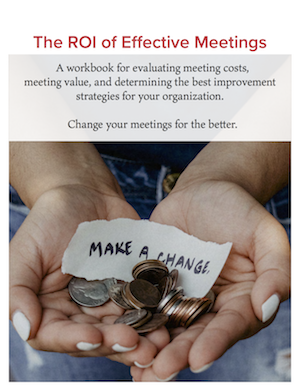We help organizations run meetings as a competitive advantage.
Every organization invests significant time, money, and energy in meetings, often without getting much back in return. Use the free resources below to understand how your organization fares. Then, contact us to learn how we can help your organization use meetings to create a competitive advantage!
Webinar Recording: The ROI of Effective Meetings
Hosted by Leadership Strategies, Presented by Michael Wilkinson and Elise Keith
ROI Workbook and Spreadsheet: UPDATED for 2024!
This packet includes a workbook designed to help you evaluate the return on investment, or ROI, of your meetings, and an Excel file you can use to calculate meaningful numbers for your organization. The exercises here will help you see your meeting performance in terms of real money.
Workbook Contents
- Definitions
- Guide to Calculating the "I" in ROI
- Effective Meetings Increase Productivity
- Improving Revenue Generation and Impact
- Improving Employee Engagement and Retention
- Improving Decision Quality, Velocity, and Effort
- Action Plan for Improving Meeting ROI
- Resources
Additional Calculators: What is Your Meeting ROI?
Time is your most precious resource. See what better meetings can do for your organization. Use our online calculators to quickly assess the cost (and value) of your meetings.
Software and audio costs
Organizational costs
Total meeting costs
Efficiency savings
